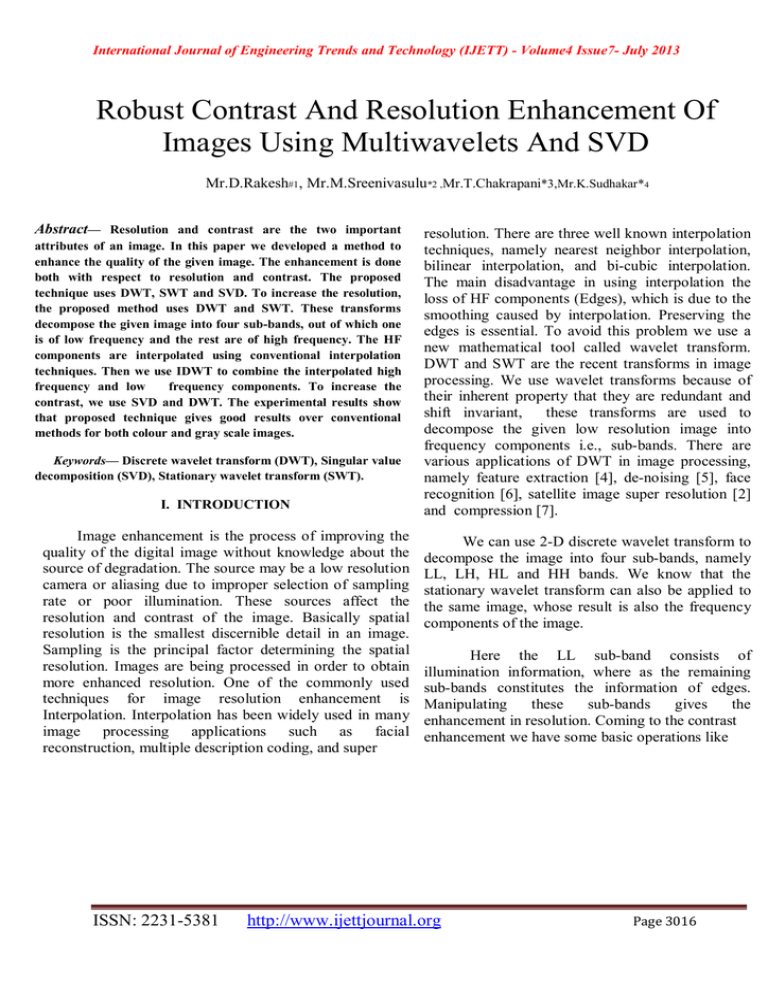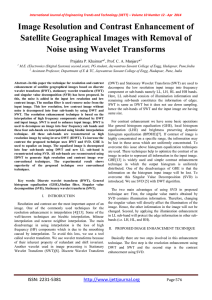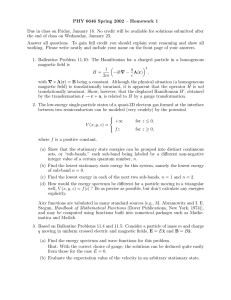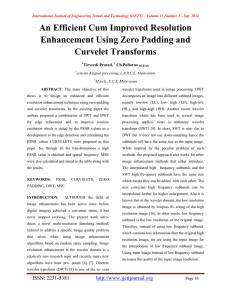Robust Contrast And Resolution Enhancement Of Images Using Multiwavelets And SVD Abstract
advertisement

International Journal of Engineering Trends and Technology (IJETT) - Volume4 Issue7- July 2013 Robust Contrast And Resolution Enhancement Of Images Using Multiwavelets And SVD Mr.D.Rakesh#1, Mr.M.Sreenivasulu*2 ,Mr.T.Chakrapani*3,Mr.K.Sudhakar*4 Abstract— Resolution and contrast are the two important attributes of an image. In this paper we developed a method to enhance the quality of the given image. The enhancement is done both with respect to resolution and contrast. The proposed technique uses DWT, SWT and SVD. To increase the resolution, the proposed method uses DWT and SWT. These transforms decompose the given image into four sub-bands, out of which one is of low frequency and the rest are of high frequency. The HF components are interpolated using conventional interpolation techniques. Then we use IDWT to combine the interpolated high frequency and low frequency components. To increase the contrast, we use SVD and DWT. The experimental results show that proposed technique gives good results over conventional methods for both colour and gray scale images. Keywords— Discrete wavelet transform (DWT), Singular value decomposition (SVD), Stationary wavelet transform (SWT). I. INTRODUCTION Image enhancement is the process of improving the quality of the digital image without knowledge about the source of degradation. The source may be a low resolution camera or aliasing due to improper selection of sampling rate or poor illumination. These sources affect the resolution and contrast of the image. Basically spatial resolution is the smallest discernible detail in an image. Sampling is the principal factor determining the spatial resolution. Images are being processed in order to obtain more enhanced resolution. One of the commonly used techniques for image resolution enhancement is Interpolation. Interpolation has been widely used in many image processing applications such as facial reconstruction, multiple description coding, and super ISSN: 2231-5381 resolution. There are three well known interpolation techniques, namely nearest neighbor interpolation, bilinear interpolation, and bi-cubic interpolation. The main disadvantage in using interpolation the loss of HF components (Edges), which is due to the smoothing caused by interpolation. Preserving the edges is essential. To avoid this problem we use a new mathematical tool called wavelet transform. DWT and SWT are the recent transforms in image processing. We use wavelet transforms because of their inherent property that they are redundant and shift invariant, these transforms are used to decompose the given low resolution image into frequency components i.e., sub-bands. There are various applications of DWT in image processing, namely feature extraction [4], de-noising [5], face recognition [6], satellite image super resolution [2] and compression [7]. We can use 2-D discrete wavelet transform to decompose the image into four sub-bands, namely LL, LH, HL and HH bands. We know that the stationary wavelet transform can also be applied to the same image, whose result is also the frequency components of the image. Here the LL sub-band consists of illumination information, where as the remaining sub-bands constitutes the information of edges. Manipulating these sub-bands gives the enhancement in resolution. Coming to the contrast enhancement we have some basic operations like http://www.ijettjournal.org Page 3016 International Journal of Engineering Trends and Technology (IJETT) - Volume4 Issue7- July 2013 General histogram equalization (GHE), Local histogram equalization (LHE) and brightness preserving Dynamic histogram equalization (BPDHE). General histogram equalization is one of the widely used and simple contrast enhancement techniques, in which the output histogram is uniformly distributed. One of the disadvantages of GHE is that the information laid on the histogram or probability distribution function (PDF) of the image will be lost. Similarly the other methods have their own disadvantages. In this paper, we use a combination of DWT and SVD algorithm. Singular value decomposition (SVD) of an image, which can be interpreted as a matrix, is written as follows: A = UAΣAVTA --------(1) Where UA and VA are orthogonal square matrices known as Hanger and aligner, respectively, and the ΣA matrix contains the sorted singular values on its main diagonal. The idea of using SVD for image equalization comes from this fact that ΣA contains the intensity information of a given image. SVD can be used to deal with an illumination problem. The method uses the ratio of the largest singular value of the generated normalized matrix, with zero mean and unity variance of, over a normalized image which can be calculated according to ξ = Max(Σn) Max(ΣA) ------(2), Where ΣN is the singular value matrix of the synthetic intensity matrix at zero mean and unity variance. This coefficient can be used to regenerate an equalized image using EequalizedA = UA (ξΣA) VAT----(3) Here we take the help of DWT to decompose this image into different sub-bands. The resultant can be obtained by combining the sub-band images using IDWT. II.Proposed image enhancement technique Basically there are two steps involved in this image enhancement operation. In the first step, we do resolution enhancement. And the second step is the contrast enhancement. Resolution enhancement uses the combination of DWT and SWT, and contrast enhancement uses the combination of SVD andDWT. ISSN: 2231-5381 A.Resolution enhancement: We know that the low resolution image can be obtained by passing the high resolution image through a low pass filter in wavelet domain, which implicitly means that the LL sub-band is the low resolution of the original image. The proposed enhancement process is based on the interpolation of HF sub-band images obtained by DWT and input image. The edge detail is enhanced by using intermediate stage using SWT. DWT can be used to decompose the input image into different sub-bands, and then the HF sub-bands are interpolated. HF sub-bands obtained by SWT of input are incremented into interpolated HF sub-bands in order to correct the estimated co-efficient. In parallel input image is also interpolated separately and corrected HF sub-bands and interpolated input image are combined through IDWT, to achieve high resolution output. Here the main role of wavelet transforms is to preserve the HF components. One level DWT can be used to decompose the input image to different sub-bands. While interpolating the HF components, we used bicubic interpolation with enlargement factor of 2. Down sampling in each of DWT sub-bands causes information loss in respective sub-bands. So we use SWT to minimize the error. It can be observed that interpolated HF sub-bands and the SWT HF sub-bands have same size, and hence they can be added together. Basically the LL subband is the illumination information of low resolution image. Instead of using LL sub-band, which contains less information than the original image we are using input image itself. Use of input image instead of LF sub-band increases the quality of super resolved image when compared with the conventional techniques. This is due to the fact that, the interpolation of HF components in HF sub-bands and using the corrections obtained by HF components of SWT of the input image will preserve more HF components than the ordinary interpolation. http://www.ijettjournal.org Page 3017 International Journal of Engineering Trends and Technology (IJETT) - Volume4 Issue7- July 2013 B. Contrast enhancement: The output of the resolution enhancement module will be taken as the input to this module. The main tools that we use here are SVD and DWT. It is already known that singular value matrix obtained by SVD contains the illumination information. So we have to change this matrix to change the contrast of the image. Any changes made to this matrix will not affect the other attributes of the image. The DWT is used to divide the image into sub-bands. We know that the edges are concentrated on LH, HL, HH sun-bands. Hence even if we separate the HF components and apply some transformations on the LF will not cause any damage to the edge components. Hence after reconstruction the image looks sharper too. The key steps involved in this process are as follows: First we will apply DWT on the input image and in parallel we improve its contrast using GHE and find its DWT. Now calculate the hanger (U), aligner (V) and singular value matrix (SVM) for the LL sub-bands obtained above. Find the maximum element in both the SVMs and take their ratio (ξ). Now calculate the new STM and estimate the new LL sub-band. LLA(new)=ULLA ΣLLAVTLLA Low Resolution, Low Contrast image LL HL LH HH + + + LL HL LH HH IDWT High Resolution,Low Contrast image Calculate U,V & Σ for LL sub-band using SVD Apply GHE Estimate new Σ thereby new LL DWT IDWT LL ISSN: 2231-5381 LL HL LH HH Interpolation the HF components of DWT The estimated LL sub- band and the HF components of actual input image are now used to re-produce the contrast enhanced image. From the close observation we can see that the HF components are not disturbed. We manipulated the illumination information alone. Hence we can be sure that there is no harm to edge components.[8]. III. Block diagram The block diagram presented below explains the major steps involved in the proposed technique. Initially we tool a low resolution image with poor resolution and poor illumination. The following steps are carried out to get a better version of the image. DWT SWT HL LH HH Calculate U,V & Σ for LL sub-band using SVD High Resolution, High Contrast Image. Fig. Detail steps involved in the proposed technique http://www.ijettjournal.org Page 3018 International Journal of Engineering Trends and Technology (IJETT) - Volume4 Issue7- July 2013 IV. Results: Fig(c): Input Image Fig(a): Input Image Fig(d):Processed Image Fig(b):Processed Image Figures .(a) and (c) are input images, and Figures.(b) and (d) are processed images ISSN: 2231-5381 http://www.ijettjournal.org Page 3019 International Journal of Engineering Trends and Technology (IJETT) - Volume4 Issue7- July 2013 The figures shown above are the application of the proposed techniques. Totally we are presenting our output for different images. We can observe a significant enhancement in contrast and resolution compared to the input images. Here we took a satellite image and the resolution, contrast of the image has been improved significantly. The proposed technique has been tested on wellknown benchmark images, where their PSNR and MSE and visual results show the superiority of the proposed technique over the conventional and state-of-art image resolution enhancement techniques.This work is mainly preferred for low resolution images though they give enhancement output to high resolution images as well. The precision and accuracy of enhancement will be more for low resolution images when compared with high resolution images. v. Applications 1. Satellite images are usually taken from low resolution cameras. They suffer from low illumination problem. We can apply this algorithm to compensate these effects. 2. Surveillance cameras cannot take accurate images due to the relative motion between camera and vehicle. In such cases this algorithm can be used 3. In many other applications like face detection, finger print reading we can use this technique. 4.The proposed method can also used for enhance-ment of colour images 5. Other applications include facial reconstruction , multiple descriptive coding and super resolution. VI. Conclusions From the results obtained it is clear that the application of the algorithm is successful. And this application is more prominent in natural image processing .This procedure is successful in obtaining the enhanced images to obtain even the minute details when related to natural images. We can uncover the hidden details from the given images. For the resolution enhancement, we corrected the HF components according to SWT components. For contrast enhancement we have taken the help of SVD, in which singular value matrix gives the illumination content. By modifying that value, we succeeded in improving the contrast of the given image. ACKNOWLEDGEMENT We sincerely thank project co-ordinator Mr.Chakrapani, Associate Professor, SJCET, and the Staff members of ECE Dept. SJCET, family members, and friends one and all who helped us to make this paper successful. VII. Quality Estimation Measures: PARAMETER Proposed Approach (gray scale image) Proposed Approach (colour image) Existed Approach DWT and SVD PSNR 32.1654 32.0554 26.536 SSIM 0.99794 0.99804 0.72530 MSE 0.007854 0.019050 0.19727 ISSN: 2231-5381 http://www.ijettjournal.org Page 3020 International Journal of Engineering Trends and Technology (IJETT) - Volume4 Issue7- July 2013 VIII. References [1] Hasan Demirel and Gholamreza Anbarjafari, “IMAGE Resolution Enhancement by Using Discrete and Stationary Wavelet Decomposition” IEEE transactions on IMAGE PROCESSING,VOL. 20, NO.5 [2] H. Demirel and G. Anbarjafari, “Satellite image resolution enhancement using complex wavelet transform,” IEEE Geosciences and Remote Sensing Letter, vol. 7, no. 1, pp. 123–126, Jan. 2010. [3] Kirk Baker,” Singular Value Decomposition Tutorial”. March 29, 2005 [4] Y. Piao, I. Shin, and H. W. Park, “Image resolution enhancement using inter-sub-band correlation in wavelet domain,” in Proc. Int. Conf. Image Process., 2007, vol. 1, pp. I-445–448. [5] J. W. Wang and W. Y. Chen, ‘‘Eye detection based on head contour geometry and wavelet subband projection,’’ Opt. Eng., vol. 45, no. 5, pp. 057001-1--057001-12, May 2006. [6] J. L. Starck, E. J. Candes, and D. L. Donoho, ‘‘The curvelet transform for image de-noising,’’ IEEE Trans. Image Process., vol. 11, no. 6, pp. 670-684, Jun. 2002. [7] C. C. Liu, D. Q. Dai, and H. Yan, ‘‘Local discriminant wavelet packet coordinates for face recognition,’’ J. Mach. Learn. Res., vol. 8, pp. 1165-- 1195, 2007. [8] M. Lamard, W. Daccache, G. Cazuguel, C. Roux, and B. Cochener, ‘‘Use of a JPEG-2000 wavelet compression scheme forcontent-based ophthalmologic retinal images retrieval,’’ in Proc. 27th IEEE EMBS, 2005, pp. 4010--4013. T.Chakrapani received his B.Tech degree in Electronics & Communications Engineering from JNTU Hyderabad. He then received his M.Tech in Microwave Engineering from Siddhartha Engineering College, Vijayawada. He started his career as an Assistant Professor in 2005 and currently he is working as an Asssociate Professor in Department of ECE at St.Johns College of Engineering & Technology, Yemmiganur Kurnool (AP, India). T.Chakrapani has guided several B.Tech Projects and M.Tech dissertations. He has published several research papers in National/International Journals/Conference ISSN: 2231-5381 http://www.ijettjournal.org ABOUT AUTHORS 1. Mr.D.Rakesh, M TECH from St.Johns college of engg and technology,Dept of ECE,JNTU Anantapur, Kurnool ,India, B.Tech degree from RGMCET, Nandyal , Kurnool, A.P and received Diploma degree from Dr.Y.C.James Yen Rural Polytechnic College, Kuppam, Chittoor Dist, A.P, India. His Interested areas are Communications, Embedded systems and Digital systems. @:drakeshctr@gmail.com Born on JUNE 10 1980 at Varli village Kalyandurg Anantapur (AP, India)., M.Sreenivasulu received his B.Tech degree in Electronics & Communications Engineering from S.V University, Tirupati in 2001. .He then received his M.Tech in Digital Electronics&Communication Systems from JNTU University in 2006 and Pursuing Ph.D in the Area of Microelectromechanical Systems(MEMS) at JNT University, Hyderabad. He started his career as an Assistant Professor in 2002 and currently he is working as an Asssociate Professor in Department of ECE at St.Johns College of Engineering & Technology, Yemmiganur Kurnool (AP, India). K.SUDHAKAR received his B.Tech degree in Electronics & Communications Engineering from JNTU University in 1999.He then received his M.Tech in Communication Systems from JNTU University in 2006 and Pursuing Ph.D in Electromagntic waves in JNT University, Hyderabad. He entered in to teaching field in 2000 as a Assistant Professor and as Associate Professor & Professor. Presently he is working as Professor in ECE departmentl in St.Johns College of Engineering & Technology, Yemmiganur Kurnool (AP, India). K.SUDHAKRs guided several B.Tech Projects, M.Tech dissertations.,and published several research papers in National/International Journal/Conferences. Page 3021





